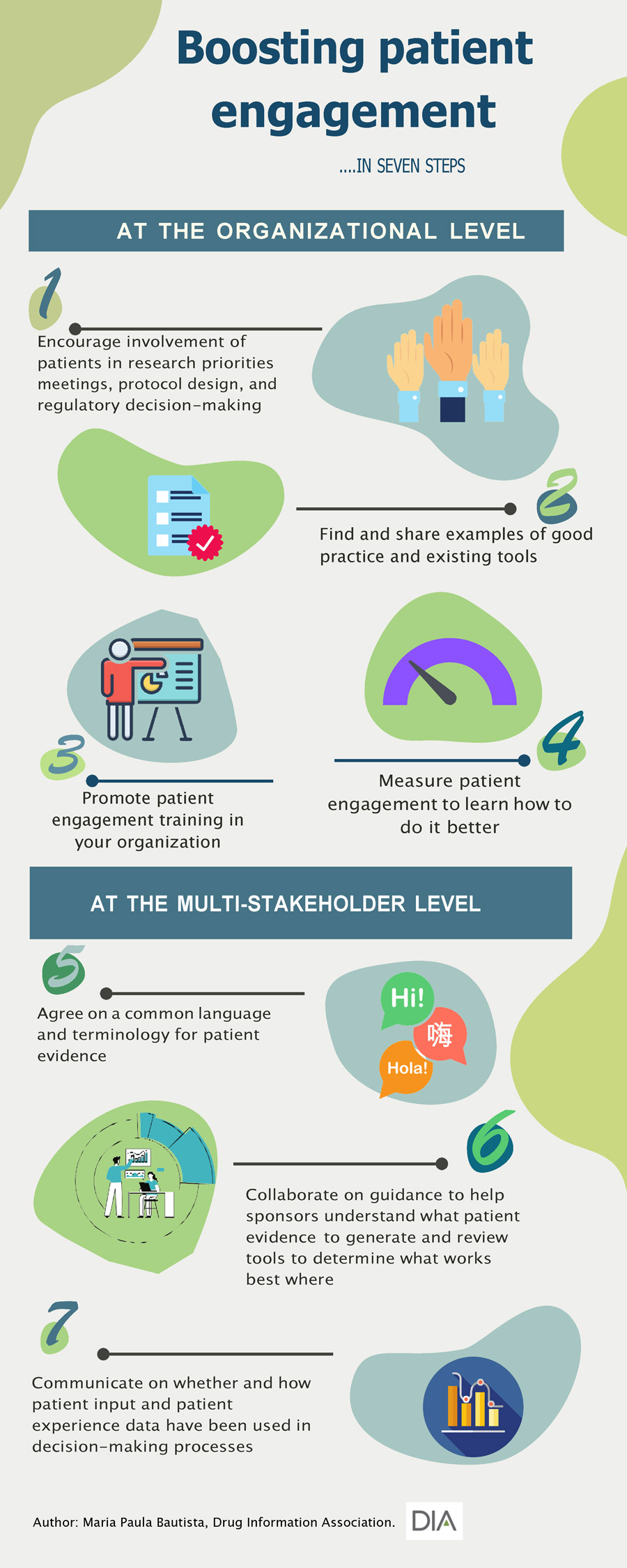
EMA
European Patients’ Forum World Duchenne Organization
Annette Bakker
Children’s Tumor Foundation Europe
Nicholas Brooke
The Synergist
PFMD
Claudia Ferreira
Drug Information Association (DIA)
EMA
Magda Chlebus
EFPIA
Sharon Gorman
Pfizer
Álmath Spooner
AbbVie
nvolving patients in drug development and decision making drives efficiency and ensures that new therapies address the real needs of patients. Industry, regulators, research foundations, and patients are actively working to improve the use of meaningful patient experience data in this process, but more action is needed. An interactive session at DIA Europe 2022, co-hosted by the European Federation of Pharmaceutical Industries and Associations and the European Patients’ Forum, explored how the system can be optimized by placing the patient and patient experience data at its center.
- Transparency: how patient evidence is used in regulatory decision making, and how this can be communicated.
- Predictability: how to ensure that patient data is fit for purpose and will be used as planned.
- Guidance: how to develop and select the right tools to generate the right evidence.
- Taking responsibility: building a patient-focused drug development ecosystem is the shared responsibility of all stakeholders.
- Capacity building: how to support patients, their organizations, and the drug development/clinical research system to deliver meaningful patient involvement.
- Culture change: how stakeholders can overcome inertia and make patient engagement the norm.
Introduction
Recruiting patients for clinical trials is often challenging, leading to delays and rising costs. Suboptimal levels of medication adherence may also lead to trial failure. Patients are the victims of these shortcomings: when a trial fails (or does not provide the information needed), a product is delayed in reaching the market or used suboptimally. This means that the needs of a patient community remain unmet.
Patients are helping to address this problem. The patient community can play a constructive role at every step of drug development, from research priority setting and clinical trial feasibility assessment, to optimizing clinical trial designs and selecting endpoints, and using their experiences to inform regulatory decisions. Patients are more likely to enroll in trials if they see clear benefits of participation for themselves and their peers.
Improving the lives of patients has always been the goal of medical research. However, instead of relying only on clinicians to determine how patients’ experiences can be improved, there is a complementary, and more direct approach: ask patients. By engaging patients at an early stage, clinical trial sponsors can raise awareness of the study among key patient communities, increase the probability that trials are designed to measure what matters to patients, and meet patient expectations.
This enhances sponsors’ capacity for demonstrating meaningful impact. For example, clinical trials in rheumatoid arthritis have been designed to reflect patient concerns over fatigue; psoriasis trial protocols have incorporated anxiety and depression in response to patient feedback; and rare disease research has worked closely with patients to understand diseases and build research projects around their experiences.
As well as being the right thing to do, involving patients and building on their insights improves the quality of work for sponsors and regulatory decision-makers. Ultimately, it is good for medical science and public health.
Working Together to Make Patient Engagement and Data Collection Happen
However, despite some progress, incentives for stakeholders to comprehensively make the cultural shift required to integrate the systematic collection and use of patient evidence into the drug development process are still lacking.
What is needed? A clear value proposition for all stakeholders to invest in generating evidence with patients. Sponsors need to know what to measure and which metrics to use, and to understand how this evidence can complement the decision-making process. Regulators need to be confident that robust data will be provided that has been informed by the needs of patients. Patients must be convinced that the time they invest in working with sponsors and regulators will be time well spent.
Getting Incentives Right
- Incentives for patients: Become an empowered part of discussions and solutions that better reflect their (patient) experience; development of solutions that meet their needs; better information on which to make treatment decisions.
- Incentives for researchers: Save time, improve trials, deliver better health outcomes, and facilitate approval where patient evidence is transparently considered in regulatory decision making; better product differentiation.
- Incentives for regulators: Better understand the disease burden and unmet needs to make more informed decisions, facilitate approval, and deliver better health outcomes.
An EMA multistakeholder workshop planned for Q3 2022 will take another step forward in deepening understanding between industry, regulators and, crucially, patients. The impact of dialogue can be amplified by ensuring that all stakeholders work with the same definitions. The Innovative Medicines Initiative PARADIGM project has published 87 indicators to measure the level of quality and impact of patient engagement. The challenge is to provide guidance to researchers on which measures to use under what circumstances. Based on PARADIGM’s 87 indicators, PFMD is developing a metric selector (available for testing and feedback) to help researchers and others identify how to measure patient engagement. The forthcoming guidance on patient preference studies and patient reported outcomes that will be developed through the ICH process may provide another signal on how this data could shape key decisions.
All stakeholders have work to do to improve the quality of the role they play in this emerging ecosystem. Patients can benefit from “language classes” to help them navigate the highly technical terminology of clinical research; clinicians can learn to prioritize clarity in their communication; and all parties need education on shared decision-making models. It is also time for a conversation on how to communicate about patient-focused medicines development, and how these efforts are reflected in product labels.
Change is Hard—Be Brave
Patient engagement is everybody’s responsibility. Patients can play a key role as empowered advocates and influencers prepared to drive positive change, but it is up to us all to be informed about the patient engagement tools that are already available.
Patients can continue to demand a seat at the table and to support trials that are truly patient-focused. Community Advisory Boards can provide institutes with additional advice on research ethics and protocols. Clinicians can benefit from having patients as experts and partners. Regulators can engage early with patients and sponsors to ensure that trials capture what matters to the end user and generate data that support the regulatory process and decision making.
Above all, stakeholders must be bold. Changing the status quo is never easy. It can be uncomfortable and slow, and there will be failures along the way. When patient engagement is done right, these success stories should be shared and celebrated so that others can learn from and build on them.
The systemwide movement to a new way of thinking and working is too great a challenge for any single actor. A sustainable new model can only be developed through collaboration. The speed with which this historic shift takes place will be determined by the courage and energy invested by those who see patient-focused drug development as our shared future. The destination is clear. The faster we get there, the better for all. Now is the time to start doing.
Seven Steps for Boosting Patient Engagement
- Insist on meaningful involvement of patients in meetings on research priorities, protocol design, and regulatory decision making
- Find and share examples of good practice and existing tools
- Promote patient engagement training in your organization
- Measure patient engagement to learn how to do it better.
In multistakeholder fora
- Agree on a common language and terminology for patient evidence
- Collaborate on guidance to help sponsors understand what patient evidence to generate, and review tools to determine what process works best in which circumstance
- Communicate on whether and how patient input and experience data have been or will be used in decision-making processes.

Annex: Examples of patient engagement initiatives and key developments
- ICH has developed a reflection paper on patient-focused drug development, including patient preference studies and patient reported outcomes (PROs) that will be further developed into guidance.
- Driven by the 21st Century Cures Act, the US FDA has developed patient-focused drug development guidance documents and published an assessment of the use of patient-engagement data in regulatory decision making. There has been an increase in the inclusion of PROs in product labeling.
- FDA Project Patient Voice pilot provides an online platform for patients, caregivers, and healthcare providers to look at patient-reported symptoms data collected from cancer trials.
- PFMD is developing a Patient Engagement and Patient Experience Data Taxonomy and Roadmap to help all stakeholders speak the same language and to prioritize the best tools and methodologies for a given study phase or objective.
- The EMA CHMP work plan and EMA Regulatory Science Strategy both clearly focus on developing a robust methodology for patient evidence.
- The EMA includes patients as committee members and in various other activities all along the medicines’ regulatory lifecycle. EMA has approved medicines with PROs as part of the supporting evidence, e.g.:
- Tagrisso (non-small cell lung cancer): PRO information included in SmPC; time to deterioration in health-related quality of life (HRQoL).
- Kymriah (leukemia/lymphoma): PRO information included in SmPC; indicating clinically meaningful improvement in HRQoL following Kymriah infusion.
- Lutathera (gastroenteropancreatic cancer): PRO information included in SmPC; indicating an improvement in the overall global HRQoL for patients on Lutathera treatment.
- The EMA CHMP issued a positive opinion on a framework for assessing patient preference studies based on the work of IMI PREFER.
Innovative Medicines Initiative (IMI)
- IMI PREFER developed a large series of indicators and metrics for capturing patient preferences.
- IMI PROactive developed a new patient-reported outcome tool to capture physical activity experiences of people with COPD.
- IMI PARADIGM created a complete toolbox for assessing the impact of patient engagement activities, guidelines on contracts and conflicts of interest, and a code of conduct.
- IMI Connect4Children is creating a collaborative pediatric network to speed high-quality clinical trials in children while amplifying the voices of young patients and their families.
- IMI EU-PEARL is a strategic partnership between the public and private sectors to shape the future of clinical trials by creating a framework for patient-centric integrated research platform (IRP) trials through which novel techniques and treatments developed by multiple companies and organizations are tested.
- IMI H2O (Health Outcomes Observatories) brings together the public and private sectors to create a standardized data governance and infrastructure across Europe to incorporate patients’ experiences and preferences in decisions affecting their individual healthcare and those of the entire patient community.
- IMI Gravitate Health aims to equip and empower citizens with digital information tools that make them confident, active, and responsive in their patient journey, specifically encouraging safe use of medicines for better health outcomes and quality of life.
Additional Examples
- Patient-Focused Medicines Development (PFMD) has developed the Patient Engagement Management Suite of tools, including guides, good practices, training, legal contracts, and the SYNAPSE Patient Engagement network.
- The multistakeholder European Patients’ Academy on Therapeutic Innovation (EUPATI) has delivered training to patients and patient advocates for more than a decade.
- The Children’s Tumor Foundation has developed an integrated R&D enabling platform aimed at accelerating the path from discovery to clinical benefit. The highly patient-centric platform features initiatives such as a patient registry, a clinic network, and clinical trial endpoint development.
- The 24 European Reference Networks (ERNs) include European Patient Advocacy Groups to ensure that the patient’s voice is heard.

